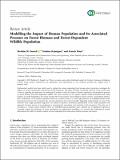| dc.description.abstract | Mathematical models have been widely used to explain the system originating from human-nature interaction, investigate the impacts of various components, and forecast system behaviour. This paper provides a profound reference to the current state of the art regarding the application of mathematical models to study the impact of human population and population pressure on forest biomass and forest-dependent wildlife. The review focused on two aspects, namely, model formulation and model analysis. In model formulation, the review revealed that socioeconomic status influences forest resource consumption patterns, thus, stratification of the human population based on economic status is a critical phenomenon in modelling human-nature interactions; however, this component has not been featured in the reviewed models. Regarding model analysis, in most of the reviewed work, single parameter approach was utilized to perform uncertainty quantification of the model parameter; this approach has been proven to be inadequate in measuring the uncertainty and sensitivity of the parameter. Thus, the use of correlation or variance based methods, which are multidimensional parameter space methods are of significant importance. Generally, despite the limitations of many assumptions in mathematical modelling, it is revealed that mathematical models demonstrate the ability to handle complex systems originating from interactions between humans and nature. | en_US |

